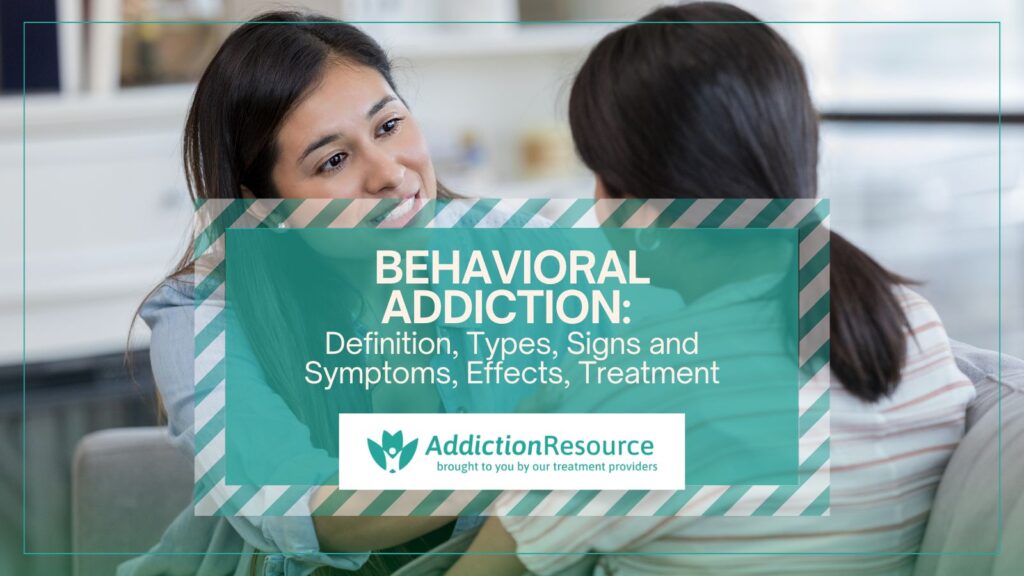
Behavioral addiction involves persistent participation in certain activities that provide gratification, even when they lead to unfavorable outcomes, resembling patterns seen in substance dependence. These behaviors, such as gambling, internet use, and shopping, activate the brain’s reward system, leading to psychological dependency. Unlike substance addiction, behavioral addiction lacks physical withdrawal but still causes significant life disruptions and co-occurring disorders.
The prevalence of behavioral addiction in the U.S. is rising, with nearly 1% to 3% of adults struggling with some form of compulsive behavior, as reported by Brock H, Rizvi A, Hany M. et al. 2024, titled “Obsessive-Compulsive Disorder.” According to Statista, 40% of U.S. online users aged 18 to 22 years reported feeling addicted to social media, while during a 2023 survey conducted in the United States, 56% of Gen Z respondents claimed to feel addicted to their phones. Behavioral addictions co-occur with mental health conditions, with 20% of individuals experiencing both addiction and anxiety or depression.
Types of behavioral addictions include gambling addiction, internet addiction, pornography addiction, sex addiction, shopping addiction, smartphone addiction, and video game addiction. Each condition involves compulsive, repetitive behaviors that interfere with daily life. Excessive engagement in these activities alters brain chemistry, reinforcing compulsive patterns akin to substance addiction.
Signs and symptoms of behavioral addiction vary, but include mood swings, secrecy, withdrawal from social activities, neglect of responsibilities, and difficulty controlling urges. Physical symptoms such as sleep disturbances, stress-related health issues, and fatigue accompany behavioral addictions. Individuals, especially professionals and veterans, exhibit avoidance behaviors, increased secrecy, and deteriorating job performance.
The effects of behavioral addiction extend to financial, emotional, and social consequences. Individuals experience strained relationships, increased anxiety, depression, and reduced productivity. Severe cases lead to legal troubles, financial debt, and social isolation. A study by Sinha R. et al. 2008, titled “Chronic stress, drug use, and vulnerability to addiction,” shows that chronic behavioral addiction is linked to higher stress hormone levels, worsening both mental and physical health over time.
The most effective treatment methods for behavioral addiction include CBT, which helps individuals recognize and change destructive thought patterns, family therapy to rebuild relationships, and support groups like Gamblers Anonymous. Medication, mindfulness practices, and holistic treatment approaches also play an important role in recovery. Early intervention and tailored therapy options significantly improve long-term outcomes for individuals with behavioral addictions.
What is the Definition of Behavioral Addiction?
Behavioral addiction is a condition characterized by compulsive engagement in non-substance-related activities despite negative consequences on an individual’s daily life. Unlike substance addiction, which involves chemical dependency, behavioral addiction is driven by psychological dependency and impulse control issues. Individuals experiencing behavioral addiction struggle to regulate their actions, even when these behaviors interfere with relationships, work, or personal well-being. Common examples include gambling addiction, internet addiction, and compulsive shopping.
Neuroscientific research has shown that behavioral addiction shares similar neural mechanisms with substance addiction, particularly involving the brain’s reward system. A study by Wise RA, Jordan CJ. et al. 2021, titled “Dopamine, behavior, and addiction,” indicates that dopamine, a neurotransmitter associated with pleasure and reinforcement, plays a key role in the compulsivity seen in behavioral addictions. Repetitive engagement in addictive behaviors leads to increased dopamine release, reinforcing the habit and making it difficult to stop. Over time, changes in neural pathways result in diminished impulse control, making individuals more prone to compulsive actions, according to Mitchell MR, Potenza MN. et al. 2014, titled “Recent Insights into the Neurobiology of Impulsivity.”
The Diagnostic and Statistical Manual of Mental Disorders (DSM-5) recognizes gambling disorder as a behavioral addiction, highlighting criteria such as impaired control, continued behavior despite harm, and significant distress. While other compulsive behaviors, such as gaming disorder and internet addiction, are under ongoing research, they share characteristics of psychological dependency and compulsion. These behaviors involve preoccupation, withdrawal symptoms, and the inability to reduce engagement despite recognizing harmful consequences.
What Are the Core Components of Behavioral Addiction?
The core components of behavioral addiction are salience, tolerance, withdrawal, conflict, relapse, and mood modification. These elements help define the diagnostic criteria for behavioral addiction and serve as key behavioral markers that indicate compulsive engagement in a particular activity. Behavioral addiction follows a pattern similar to substance addiction, where diagnostic criteria focus on compulsive engagement, psychological dependency, and loss of impulse control.
The core components of behavioral addiction are as follows:
- Salience: Salience refers to the dominance of the addictive behavior in an individual’s thoughts, emotions, and daily life. The activity becomes the most important focus, neglecting responsibilities, hobbies, and social interactions. According to a Nothingam Trent University study titled “The Psychology of Addictive Behaviour,” affected individuals frequently think about or anticipate engaging in the behavior, even when occupied with other tasks.
- Tolerance: Tolerance develops when an individual needs to engage in the behavior more frequently or intensely to achieve the same level of satisfaction. Over time, the brain adapts to the stimulus, requiring greater involvement to experience the same pleasure. This pattern, similar to substance addiction, reinforces compulsive engagement and reduces impulse control.
- Withdrawal: Withdrawal symptoms arise when an individual attempts to reduce or stop the addictive behavior. These symptoms are psychological, such as irritability, anxiety, or restlessness, and in severe cases, they lead to depression. Research by the American Psychological Association on gambling and gaming addiction has shown that withdrawal effects drive individuals back to the behavior, making cessation difficult.
- Conflict: Conflict occurs when the addictive behavior interferes with personal, professional, or social life. Individuals experience internal struggles, knowing that their actions are harmful but feeling unable to stop. This leads to guilt, strained relationships, and decreased productivity. Conflict is a key behavioral marker in diagnosing compulsive disorders.
- Relapse: Relapse is the tendency to return to the addictive behavior after an attempt to quit or reduce engagement. Studies on behavioral addiction by Volkow ND, Michaelides M, Baler R. et al. 2019, titled “The Neuroscience of Drug Reward and Addiction,” indicate that relapse follows similar neural pathways as substance addiction, with dopamine-driven reinforcement making it difficult to maintain abstinence. Even after long periods of avoidance, exposure to triggers leads to a rapid return to compulsive behavior.
- Mood Modification: Mood modification describes the emotional regulation effect of the addictive behavior. Individuals engage in the activity to escape negative emotions, relieve stress, or enhance pleasure. This creates a psychological dependency, reinforcing continued engagement as a coping mechanism despite long-term negative consequences.
How Does Behavioral Addiction Differ from Substance Addiction?
Behavioral addiction differs from substance addiction in that it does not involve the ingestion of a chemical substance but instead relies on compulsive engagement in certain activities. While both types of addiction share patterns of psychological addiction and impaired impulse control, behavioral addiction lacks the physical withdrawal symptoms seen in substance dependence.
Research, including studies from the National Institute on Drug Abuse (NIDA), shows that both behavioral and substance addictions affect similar brain regions, particularly those involved in reward processing and dopamine release. However, substance addiction introduces external chemicals that alter brain chemistry, whereas behavioral addiction reinforces compulsive behaviors through repeated neural stimulation.
Another key difference in behavioral addiction and substance addiction is the neurobiological effects of each addiction. Substance abuse leads to physiological dependence, requiring medical detoxification, whereas behavioral addiction is primarily treated through cognitive and behavioral interventions. Despite these distinctions, both conditions exhibit relapse patterns and compulsive engagement, highlighting their shared psychological mechanisms.
What Are the Common Types of Behavioral Addictions?
The common types of behavioral addictions are gambling addiction, internet addiction, masturbation addiction, pornography addiction, sex addiction, shopping addiction, smartphone addiction, sugar addiction, technology addiction, and video game addiction. Each of these addictions involves compulsive engagement in specific behaviors, leading to negative consequences in an individual’s life.
The common types of behavioral addictions are as follows:
Gambling Addiction
A gambling addiction, also known as pathological gambling, is characterized by an uncontrollable urge to gamble despite adverse consequences. This addiction leads to severe financial issues, legal troubles, and strained personal relationships. The National Council on Problem Gambling (NCPG) estimates that approximately 5 million Americans meet the criteria for compulsive gambling. Young men are particularly affected, with research by Yale Medicine showing that 2% to 7% of youths develop a gambling addiction, compared with about 1% of adults, and many gambling disorders begin in adolescence.
Internet Addiction
Internet addiction involves excessive and problematic use of online activities such as social media, gaming, and browsing. It disrupts daily life by causing social isolation, reduced productivity, and mental health issues. Although internet addiction rates are difficult to quantify in the U.S., global research suggests that prevalence varies widely. A study in China titled “Prevalence of Internet addiction and its association with social support and other related factors among adolescents in China” reported a 10.4% prevalence among adolescents, with 10.2% having moderate and 0.2% having severe internet addiction.
Masturbation Addiction
Masturbation addiction refers to compulsive engagement in masturbation that results in distress and negative consequences in various aspects of life. Those struggling with this addiction report feelings of guilt, shame, and anxiety, affecting their social and emotional well-being. Although there is limited specific data on masturbation addiction, it falls under the broader category of hypersexual behavior, which affects approximately 3% to 6% of the U.S. population, according to Garcia FD, Thibaut F. et al. 2010, titled “Sexual addictions. The American Journal of Drug and Alcohol Abuse.”
Pornography Addiction
Pornography addiction is marked by the compulsive consumption of pornographic material despite negative effects on personal relationships, work performance, and mental health. Individuals with this addiction experience a diminished interest in real-life intimacy and struggle with guilt and emotional distress. According to a self-reported study by Grubbs JB, Kraus SW, and Perry SL. et al. 2019, titled “Self-reported addiction to pornography in a nationally representative sample: The roles of use habits, religiousness, and moral incongruence,” roughly 11% of American men and 3% of American women considered themselves as having a pornography addiction.
Sex Addiction
Sex addiction, also known as hypersexual disorder, involves persistent and overwhelming sexual urges, fantasies, or behaviors that disrupt daily life. It leads to risky sexual practices, relationship difficulties, and emotional distress. Research by the Mayo Clinic suggests that in the US, between 3% and 10% of adults struggle with symptoms consistent with compulsive sexual behavior or sex addiction, with men being more affected than women. The negative consequences of sex addiction extend to mental health, social interactions, and professional responsibilities.
Shopping Addiction
Shopping addiction, or compulsive buying disorder, is characterized by an uncontrollable urge to shop, resulting in financial problems, emotional distress, and conflicts in relationships. Those affected with shopping addiction accumulate significant debt and experience anxiety or depression linked to their compulsive spending habits. In the United States, compulsive buying disorder affects approximately 5.8% of the adult population, according to a study by Black DW. et al. 2007, titled “A review of compulsive buying disorder” with a higher prevalence of shopping addiction among women.
Smartphone Addiction
Smartphone addiction is defined by excessive use of smartphones, leading to dependency that affects mental health, sleep patterns, and social interactions. Individuals struggling with this addiction experience reduced productivity, increased stress, and difficulty maintaining real-life relationships. California State University reports that an estimated 10%, or 33.19 million Americans, are addicted to social media, a closely related condition that contributes to smartphone addiction.
Sugar Addiction
Sugar addiction is characterized by an intense craving for sugary foods and beverages, resulting in overconsumption and associated health risks, such as obesity and diabetes. Research by Westwater ML, Fletcher PC, Ziauddeen H. et al.. 2016, titled “Sugar addiction: the state of the science” shows that sugar activates the brain’s reward system similarly to addictive substances, leading to dependency and withdrawal-like symptoms. Although not formally classified as sugar addiction, the overconsumption of sugar remains a major public health concern in the United States, with an increasing number of studies highlighting its impact on behavior and overall well-being. According to data from the University of Georgia, the US consumes more than 300% of the daily recommended amount of added sugar on average.
Technology Addiction
Technology addiction encompasses compulsive behaviors related to the use of digital devices, including excessive engagement with social media, online content, and video games. It leads to social isolation, decreased physical activity, and negative psychological effects such as anxiety and depression. In the US, a significant portion of internet users, around 48%, consider themselves suffering from technology addiction or somewhat addicted to digital devices, with 31% of adults reporting being online “almost constantly,” according to a report by Statista.
Video Game Addiction
Video game addiction is a behavioral disorder characterized by excessive and compulsive gaming that interferes with daily responsibilities, relationships, and mental health. Those affected neglect work, school, and personal well-being due to prolonged gaming sessions. The prevalence of video game addiction in the United States varies, with Cleveland Clinic estimates that video game addiction, or internet gaming disorder, affects between 1.7% and 10% of the U.S. population, with the range varying due to differing diagnostic criteria. Young males are at higher risk of developing video game addiction. Research continues to explore the long-term psychological and social effects of this addiction.
What Are the Signs and Symptoms of Behavioral Addictions?
The signs and symptoms of behavioral addictions are compulsive engagement in the behavior, loss of control, secrecy, neglect of responsibilities, mood swings, tolerance, withdrawal symptoms, social isolation, financial problems, preoccupation with the behavior, and repeated failed attempts to quit. These symptoms arise due to changes in brain function, particularly in the reward system and impulse control mechanisms, leading to persistent engagement despite negative consequences.
The signs and symptoms of behavioral addictions are as follows:
- Compulsion to Engage in the Behavior: Compulsion is the uncontrollable urge to engage in an addictive behavior despite negative consequences. This occurs due to hyperactivity in the brain’s reward circuits, primarily involving the dopamine system, which reinforces repeated engagement. Over time, the brain forms rigid behavioral loops, making it increasingly difficult to stop. According to a study by Brock H, Rizvi A, Hany M. et al. 2024, titled “Obsessive-Compulsive Disorder,” compulsive behaviors affect 1% to 3% of the global population, characterized by intrusive thoughts, known as obsessions, and repetitive actions, or compulsions. American Psychiatric Association indicates that over 5% of the U.S. population struggles with compulsive behavioral patterns, with higher rates among those in high-stress professions and military personnel exposed to trauma.
- Loss of Control: Loss of control refers to an inability to regulate the frequency, intensity, or duration of a behavior. The prefrontal cortex, responsible for impulse control and decision-making, becomes less effective as addiction progresses. This leads to increased engagement, even when the person consciously wants to stop. Research shows that 8–10% of Americans suffer from impulse control disorders, which co-occur with behavioral addictions. Among veterans, rates of impaired impulse control are higher due to PTSD and chronic stress.
- Secrecy and Deception: Many individuals with behavioral addictions engage in secrecy to hide the extent of their behaviors from family, friends, or colleagues. This is driven by fear of judgment, guilt, and the awareness that their actions are problematic. Neuroscientific studies suggest that the amygdala, which processes fear and emotional responses, plays a role in this defensive behavior. Professionals in high-responsibility roles, such as doctors and corporate executives, are particularly prone to secretive behaviors due to concerns over reputational damage, with estimates by The Guardian indicating that up to 15% of professionals with addictions conceal their struggles.
- Neglect of Responsibilities: As addiction progresses, affected individuals begin to ignore work, household duties, and social obligations. This occurs because the brain prioritizes addictive behavior over other important tasks, a process linked to altered dopamine and serotonin signaling. Alavi SS et al. 2012 in their study titled “Behavioral Addiction versus Substance Addiction: Correspondence of Psychiatric and Psychological Views” found that up to 20% of employees suffering from behavioral addictions exhibit a decline in work performance, tardiness, or absenteeism. Among veterans, addiction-related neglect of responsibilities is closely tied to co-occurring mental health disorders, affecting over 30% of those diagnosed with PTSD.
- Mood Swings and Emotional Instability: Behavioral addictions are associated with emotional highs and lows, ranging from euphoria during engagement to irritability and depression when deprived of the activity. This results from fluctuations in neurotransmitters such as dopamine and endorphins, which regulate pleasure and mood. The National Institute on Drug Abuse, suggests that individuals with addictions are twice as likely to suffer from mood disorders, with veterans experiencing a heightened risk due to combat-related trauma.
- Tolerance and Escalation: Over time, individuals require more frequent or intense engagement in the addictive behavior to achieve the same level of satisfaction. This tolerance develops due to neuroadaptive changes in the brain’s reward pathways, particularly in dopamine receptors, reducing sensitivity to pleasurable stimuli. Research on compulsive gamblers shows that 60% report escalating betting amounts over time, A study by Nakshine VS., et al. 2022, titled “Increased Screen Time as a Cause of Declining Physical, Psychological Health, and Sleep Patterns: A Literary Review” on internet addiction indicate that users gradually increase screen time, sometimes exceeding 10 to 12 hours daily.
- Withdrawal Symptoms: Withdrawal symptoms occur when an individual experiences distress, anxiety, irritability, or even physical discomfort upon stopping the behavior. Unlike substance addiction, behavioral addiction withdrawal is primarily psychological, linked to imbalances in neurotransmitters such as dopamine and cortisol. Surveys by Rani S, Sinha N, Kumar R. et al. 2024 titled “Prevalence of internet addiction and its relationship with insomnia, depression, anxiety, and stress among medical students of a tertiary care medical institute of Eastern India” indicate that 31.2% of students had internet addiction, 24.2% had clinical insomnia, 58.1% had stress, 68.8% had anxiety, and 64.6% had depression. Gambling addicts exhibit symptoms similar to drug withdrawal, including agitation and mood swings.
- Social Isolation and Relationship Problems: As addiction intensifies, individuals withdraw from friends, family, and social activities in favor of the addictive behavior. This is driven by the brain’s shifting priorities, where social bonding becomes secondary to the addictive stimulus. Divorce rates for those dealing with gambling issues are estimated to be around 40% for problem gamblers and approximately 54% for pathological gamblers, according to a study by the National Opinion Research Center – NORC., titled “Gambling Impact and Behavior Study.” Among veterans, behavioral addictions contribute to increased social isolation, compounding the effects of PTSD and depression.
- Financial Problems and Reckless Spending: Many behavioral addictions, particularly gambling, shopping, and online gaming, lead to financial instability due to excessive spending. This occurs because the brain’s decision-making centers become impaired, reducing risk awareness. Data by Quit Gamble shows that 23% of problem gamblers accumulate significant debt, while shopping addicts experience financial distress, with an estimated 5% to 8% of Americans engaging in compulsive buying behaviors.
- Preoccupation with the Behavior: Individuals with behavioral addictions think about their addictive behavior even when not engaging in it. This cognitive preoccupation stems from increased activity in the brain’s reward-related areas, such as the nucleus accumbens. Research by Bhattacharya S. et al. 2019 titled “Nomophobia,” published in the Journal of Family Medicine and Primary Care on smartphone addiction, shows that 45% of heavy users feel anxious when separated from their devices, while gaming addicts spend an average of 4 to 6 hours daily planning their next gaming session.
- Failed Attempts to Quit: Many individuals recognize their addiction and attempt to stop but fail repeatedly. This is due to the reinforcing nature of the behavior, changes in impulse control, and increased cravings when deprived of the activity. Studies on compulsive internet users indicate that over 70% have unsuccessfully tried to reduce their usage, while 90% of pathological gamblers relapse within the first year of attempting to quit, as studied by Collier R. et al. 2008, titled “Gambling treatment options: a roll of the dice.”
How to Recognize Behavioral Addiction in Its Early Stages?
To recognize behavioral addiction in its early stages, individuals should observe subtle behavioral, emotional, and cognitive changes that indicate increasing dependency on a particular activity. These early signs appear mild but gradually escalate, affecting daily functioning and personal relationships. Identifying these warning signs early helps prevent full-blown addiction and allows for timely intervention.
To recognize behavioral addiction in its early stages, the following subtle signs are noticed:
- Irritability and Restlessness: A person in the early stages of addiction becomes unusually irritable or restless when unable to engage in the behavior. This occurs due to minor withdrawal effects as the brain starts to crave dopamine stimulation associated with the activity. A study on university students by Alavi SS, Maracy MR, Jannatifard F, Eslami M. et al. 2011, titled “The effect of psychiatric symptoms on the internet addiction disorder in Isfahan’s University students” reveal that individuals who are restricted from using their devices report increased frustration, with some showing signs of agitation and mood instability.
- Avoidance of Responsibilities: Individuals begin neglecting tasks at work, school, or home to spend more time engaging in addictive behavior. This happens as the brain’s reward system starts prioritizing immediate gratification over long-term obligations. Workplace research by Vaghefi I et al. 2013, titled “Can it hurt productivity? An investigation of Addiction,” shows that employees with emerging behavioral addictions are more likely to exhibit decreased productivity, increased absenteeism, and missed deadlines.
- Preoccupation with the Behavior: In the early stages, a person frequently thinks about the behavior even when not engaging in it. This cognitive preoccupation results from increased activity in the brain’s reward centers, particularly the nucleus accumbens. Individuals with gaming or social media addiction spend excessive time planning, anticipating, or reminiscing about their activity, sometimes exceeding 4 to 6 hours of mental engagement daily.
- Justification and Rationalization: People in the early stages of addiction justify their behavior, believing they are in control. They downplay its impact or make excuses for excessive engagement. Self-justification is a defense mechanism to avoid confronting potential addiction, with individuals convincing themselves that their behavior is harmless or even beneficial.
- Increased Secrecy: A growing addiction leads to secrecy, such as hiding the extent of engagement, lying about time spent on the behavior, or deleting digital footprints. This behavior is linked to activity in the brain’s amygdala, which processes fear and emotional responses.
- Mood Swings and Emotional Dependency: A person experiences emotional highs when engaging in the behavior and lows when deprived of it. This results from fluctuating levels of dopamine and serotonin, neurotransmitters responsible for pleasure and mood regulation. Research on behavioral addictions by Grant JE, Potenza MN, Weinstein A, Gorelick DA. et al. 2010, titled “Introduction to behavioral addictions” suggests that individuals are twice as likely to experience mood instability in the early stages of addiction compared to those without addictive tendencies.
- Spending More Time Engaged in the Behavior: Initially, a person increases the duration or intensity of the behavior without realizing it. This early form of tolerance develops as the brain requires more stimulation to achieve the same level of satisfaction. A study by Onguner S et al. 2024, titled “Internet Addiction of School-Age Children and the Effects of Daily Habits” on technology addiction, indicates that individuals who once spent 1 to 2 hours online gradually increase usage to 5 or more hours daily without recognizing the shift.
- Social Withdrawal: Subtle isolation from family, friends, and social activities occur as a person prioritizes their addictive behavior. This social withdrawal is an early sign of addiction-related changes in brain function, where interpersonal interactions become less rewarding than the addictive activity. A survey by Prince B et al. 2023, titled “Impact Of Online Gaming Addiction On Social Isolation Among First-Year Sathyabama Undergraduate Students,” shows that individuals in the early stages of gaming or smartphone addiction report reduced in-person social engagement.
- Sleep Disturbances: Behavioral addictions disrupt sleep patterns, leading to insomnia, late-night engagement, or difficulty waking up. This is due to overstimulation of the brain’s reward pathways, delaying the natural production of melatonin, a hormone necessary for sleep regulation. Research by Hammad MA, Alyami MHF, Awed HS. et al. 2023, titled “The association between internet addiction and sleep quality among medical students in Saudi Arabia,” indicates that those in the early stages of addiction experience sleep disturbances more frequently than the general population.
- Repeated Unsuccessful Attempts to Cut Down: A person recognizes their excessive engagement and attempts to reduce it but struggles to do so. This is due to early-stage neuroadaptive changes in impulse control and habit formation. Petry, NM et al. 1999, in their study titled “Prevalence, Assessment, and Treatment of Pathological Gambling: A Review,” found that 50% to 70% of problem gamblers attempt to quit in the early stages but fail, reinforcing compulsive engagement over time.
How Do Behavioral Addiction Symptoms Progress Over Time?
Behavioral addiction symptoms progress over time by gradually intensifying from occasional engagement to compulsive dependence, leading to significant personal, social, and occupational consequences. This progression follows a predictable pattern, beginning with mild involvement and escalating as neural pathways in the brain reinforce addictive behaviors. Over time, individuals experience increasing loss of control, higher tolerance, and worsening psychological distress.
Behavioral addiction symptoms progress over time in the following order:
- Initial Dependence: In the early stage, individuals engage in the behavior for pleasure, stress relief, or social interaction. The brain’s reward system releases dopamine, reinforcing the habit and making the activity enjoyable. At this stage, the behavior seems harmless, and most people do not recognize it as problematic. Many individuals begin engaging in addictive behaviors casually, with internet and gaming addiction developing from recreational use.
- Escalation and Increased Tolerance: As engagement continues, individuals need to spend more time on the behavior to achieve the same level of satisfaction. This occurs due to neuroadaptive changes in the brain, where dopamine receptors become desensitized, requiring increased stimulation. Research by the American Psychological Association on gambling addiction indicates that individuals start with small bets but gradually escalate to riskier wagers over time. Similarly, social media or gaming addicts extend screen time significantly, sometimes exceeding 6 to 8 hours daily.
- Loss of Control and Preoccupation: At this stage, individuals struggle to control their behavior and begin prioritizing it over responsibilities. The brain’s impulse control mechanisms weaken, making it difficult to resist cravings or set limits. Cognitive preoccupation increases, meaning the individual frequently thinks about the behavior even when not engaging in it. Preoccupation leads to disrupted daily routines, including neglect of academics, work, or personal relationships.
- Life Disruption and Negative Consequences: As addiction worsens, individuals experience significant social, financial, and emotional consequences. Relationships suffer due to withdrawal from social activities, work performance declines, and financial instability arises from compulsive spending (e.g., gambling, shopping addiction). Individuals with severe behavioral addictions experience job loss, academic failure, or relationship breakdowns due to their compulsive behaviors.
- Compulsion and Psychological Distress: In the final stage, addiction becomes deeply ingrained, and attempts to stop result in distress, anxiety, or depression. Withdrawal symptoms, such as irritability and emotional instability, emerge when the individual is unable to engage in the behavior. The cycle of addiction is reinforced by stress, with many individuals using the behavior as a coping mechanism. A study by Saikia AM, Das J, Barman P, Bharali MD. et al. 2019, titled “Internet Addiction and its Relationships with Depression, Anxiety, and Stress in Urban Adolescents of Kamrup District, Assam” on internet addiction reveal that severe cases are associated with higher rates of anxiety disorders and depression, with 85.7% participants experiencing signs of depression and 83.3% showing signs of anxiety.
What Are the Causes of Behavioral Addictions?
The causes of behavioral addictions are rooted in a combination of genetic, psychological, and environmental factors that influence brain function and compulsive behaviors. These factors interact to create vulnerabilities, making some individuals more prone to addiction than others. Behavioral addictions arise due to a mix of inherited traits, past experiences, and situational stressors that reinforce compulsive engagement in certain activities.
The main causes of behavioral addictions are as follows:
- Genetic Predisposition: Some individuals have a genetic tendency toward addictive behaviors due to inherited differences in dopamine regulation and impulse control. A study by Learn Genetics Utah, titled “Genes and Addiction on addiction genetics indicates that variations in dopamine receptor genes (e.g., DRD2) make individuals more susceptible to compulsive behaviors. Research by Prom-Wormley, E. C., Ebejer, J., Dick, D. M., & Bowers, M. S. et al. 2017, titled “The genetic epidemiology of substance use disorder: A review” suggests that up to 50% of addiction risk is heritable, meaning individuals with a family history of substance or behavioral addiction are significantly more likely to develop similar patterns.
- Psychological Trauma and Mental Health Disorders: Past trauma, such as childhood neglect, abuse, or significant life stressors, leads individuals to engage in addictive behaviors as a coping mechanism. People with conditions like anxiety, depression, or obsessive-compulsive disorder (OCD) use addictive behaviors to temporarily relieve distress. Studies by the Substance Abuse and Mental Health Services Administration indicate that individuals with a history of trauma are twice as likely to develop compulsive behavioral patterns, with PTSD patients showing higher rates of internet and gambling addiction.
- Environmental Stressors and Social Influence: High-stress environments, peer pressure, and exposure to addictive behaviors in social settings contribute to addiction development. Workplace burnout, academic pressure, and financial stress push individuals toward compulsive behaviors for escape or relief. Research by Vuorinen I, Savolainen I, Sirola A, Oksanen A. et al. 2024, titled “The impacts of stress and loneliness on gambling and gaming problems: A nationwide longitudinal study” shows that people in high-stress professions, such as medical and corporate fields, are at a greater risk of technology and gambling addictions.
- Dopamine Dysregulation and Brain Chemistry: Behavioral addictions alter brain reward pathways, leading to compulsive engagement despite negative consequences. Over time, repeated behaviors cause changes in the prefrontal cortex (responsible for impulse control) and the limbic system (associated with emotional processing). A study by the Reach MD titled “Understanding the Brain’s Response to Social Media: A Closer Look at Dopaminergic Mechanisms” using brain imaging has shown that excessive gaming and social media use trigger similar dopamine release patterns as substance addiction, reinforcing compulsive engagement.
- Easy Accessibility and Digital Overload: The modern digital environment makes engaging in potentially addictive behaviors easier than ever. Social media, online gaming, and shopping platforms are designed to maximize user engagement through instant rewards and algorithm-driven content. Research by Amirthalingam J, Khera A. et al. 2024, titled “Understanding Social Media Addiction: A Deep Dive” on smartphone addiction reveals that individuals who spend excessive time on digital platforms are more likely to develop compulsive usage patterns, with studies showing that 30% to 40% of heavy users struggle to regulate their behavior.
Which Demographics Are Most Vulnerable to Behavioral Addiction?
Young adults, particularly those aged 18 to 25, are more vulnerable to behavioral addiction due to heightened neuroplasticity, increased stress, and greater exposure to digital environments. Moreno M.A., et al. 2011, in their study titled “Problematic Internet Use among US Youth: A Systematic Review,” indicates that 40% of college students struggle with problematic internet use, highlighting the prevalence of digital dependency in this age group.
Veterans are also at heightened risk, with 20% experiencing compulsive behaviors linked to PTSD and stress-related coping mechanisms, as studied by Tuerk PW et al. 2009, in their study titled “Diagnosis and Treatment of PTSD-Related Compulsive Checking Behaviors in Veterans of the Iraq War: The Influence of Military Context on the Expression of PTSD Symptoms.” High-stress professionals, including healthcare workers and corporate employees, face increased addiction rates, with 25% displaying signs of work-related technology dependence. Individuals with preexisting mental health conditions, such as anxiety and depression, are twice as likely to develop behavioral addictions, according to CAMH.
What are the Effects of Behavioral Addiction?
The effects of behavioral addiction are mental, emotional, social, and financial well-being. As addiction progresses, it interferes with daily functioning, leading to strained relationships, decreased productivity, and worsening psychological health. Many individuals experience compulsive urges, emotional instability, and neglect of important responsibilities, further exacerbating their struggles.
The effects of behavioral addiction are as follows:
- Financial problems: Excessive spending on addictive behaviors, such as gambling, shopping, or gaming, leads to mounting debt, financial instability, and an inability to meet basic expenses. Individuals with gambling addiction face severe financial distress, resulting in bankruptcy.
- Strained relationships: Behavioral addiction damages personal relationships by creating emotional distance, trust issues, and communication breakdowns. Partners and family members feel neglected or betrayed, leading to conflict and, in severe cases, separation or divorce.
- Increased stress and anxiety: Chronic engagement in addictive behaviors triggers heightened stress and anxiety, especially when individuals experience withdrawal or negative consequences. Research by Young KS. New York: Wiley et al. 1998, titled “Caught in the Net: How to Recognize the Signs of Internet Addiction and a Winning Strategy for Recovery” indicates that 60% of those with internet addiction report severe anxiety symptoms.
- Neglect of responsibilities: Addicted individuals prioritize their behavior over work, school, or household duties, leading to academic failure, job loss, or financial instability. For example, students with internet addiction have significantly lower academic performance.
- Loss of productivity: Compulsive engagement in addictive behaviors reduces focus, motivation, and work efficiency. Employees with technology addiction report decreased workplace performance and frequent absenteeism, affecting career growth.
- Emotional instability: Mood swings, frustration, and irritability become common as behavioral addiction affects emotional regulation. Research by Joy A. et al. 2024, titled “The Relationship between Online Gaming, Emotional Regulation and Impulsivity in Adolescents” links compulsive gambling and gaming to higher rates of emotional dysregulation and impulse control issues.
- Social isolation: Addiction leads to withdrawal from social interactions, reducing real-life relationships in favor of virtual or solitary engagements. Individuals with gaming addiction experience higher levels of loneliness and reduced social participation.
- Legal issues: Some addictions, such as gambling, shopping, or cyber-related behaviors, lead to fraud, theft, or other legal consequences. Research by Pastwa-Wojciechowska B. et al. 2011, titled “The relationship of pathological gambling to criminality behavior in a sample of Polish male offenders,” indicates that compulsive gamblers engage in illegal activities to sustain their addiction.
- Physical health decline: Prolonged addictive behaviors contribute to sedentary lifestyles, leading to obesity, cardiovascular issues, and chronic fatigue. Lebby SR, Shyam S, et al. 2023, in their study titled “Prospective Association Between Video and Computer Game Use During Adolescence and Incidence of Metabolic Health Risks: Secondary Data Analysis,” reveal that excessive gaming and internet use correlate with a higher risk of metabolic disorders.
- Depression: Addiction alters brain chemistry, leading to persistent sadness, hopelessness, and suicidal thoughts. Individuals with behavioral addictions are twice as likely to develop major depressive disorders.
- Impulsive decision-making: A weakened prefrontal cortex due to addiction results in reckless financial, social, and personal choices, increasing the likelihood of risky behaviors.
- Sleep disturbances: Excessive screen time, compulsive behaviors, and stress-related addiction symptoms lead to sleep disorders like insomnia. Research by Hammad MA, Alyami MHF, Awed HS. et al. 2024, titled “The association between internet addiction and sleep quality among medical students in Saudi Arabia,” indicates that more than 70% of individuals with internet addiction suffer from poor sleep quality.
- Decreased self-esteem: Repeated failures to control addiction and its negative consequences erode self-confidence, leading to feelings of worthlessness. Low self-esteem is a common trait among individuals with compulsive behaviors.
- Obsessive thoughts and behaviors: Addicted individuals experience constant cravings, intrusive thoughts, and compulsive engagement in their behavior, making it difficult to focus on other aspects of life. A neuroscientific study by Grassi G, Makris N, Pallanti S. et al. 2020, titled “Addicted to compulsion: assessing three core dimensions of addiction across obsessive-compulsive disorder and gambling disorder,” reveals similarities between behavioral addiction and obsessive-compulsive disorder (OCD).
- Difficulty controlling urges: The inability to resist engaging in addictive behaviors, despite negative consequences, signifies weakened impulse control. Compulsive smartphone users struggle to regulate usage, even when it disrupts their daily lives.
What is the Treatment for Behavioral Addiction?
The treatment for behavioral addiction includes a combination of therapeutic approaches, medication management, and holistic treatment methods designed to help individuals regain control over their compulsive behaviors. Effective treatment plans involve cognitive-behavioral therapy (CBT), group support systems, and mindfulness practices to address the psychological and emotional factors driving addiction. Specialized addiction treatment is also available for veterans and professionals, tailoring treatment to high-stress lifestyles and trauma-related compulsions.
The treatment for behavioral addiction is as follows:
Individual Counseling
Individual counseling involves one-on-one therapy sessions with a licensed therapist to address the root causes of addiction. Cognitive-behavioral therapy (CBT) is the most widely used approach, helping individuals identify triggers, develop healthier coping mechanisms, and restructure negative thought patterns. For example, individuals struggling with gambling addiction learn to challenge distorted beliefs about “winning streaks” and reframe their perception of risk and reward. A study by Gooding P, Tarrier N. et al. 2009, titled “A systematic review and meta-analysis of cognitive-behavioural interventions to reduce problem gambling: hedging our bets?” found that CBT is highly effective in reducing gambling behaviors, showing significant improvement at 3 months, 6 months, 12 months, and 24 months, with greater effectiveness than no treatment.
Group Therapy
Group therapy provides a supportive environment where individuals with similar addictions share their experiences and coping strategies. It encourages accountability and reduces feelings of isolation, which are common among those with behavioral addictions. Veterans suffering from compulsive internet or gaming addiction, for instance, benefit from group sessions tailored to combat-related stress and reintegration challenges.
12-Step Programs (e.g., Gamblers Anonymous, Sex Addicts Anonymous)
12-step programs offer a structured approach to addiction recovery through peer support, accountability, and a spiritual framework. Programs like Gamblers Anonymous and Sex Addicts Anonymous help individuals recognize the impact of their addiction, take responsibility, and work toward long-term recovery. The 12-step programs are especially effective for those who struggle with denial and need a step-by-step process to regain control. According to a study by Schuler A, et al. 2016, titled “Gamblers Anonymous as a Recovery Pathway: A Scoping Review,” found that GA is a cost-effective and widely available resource for individuals experiencing problem gambling issues and is an accessible treatment option.
Family Therapy
Family therapy helps repair relationships damaged by behavioral addiction by improving communication, addressing codependency, and promoting emotional support. According to Ford JJ et al. 2012, titled “Structural Therapy With a Couple Battling Pornography Addiction,” this approach is particularly beneficial for individuals whose addiction has caused conflicts with loved ones, such as those suffering from compulsive pornography or shopping addiction. Families learn to set boundaries in therapy, support recovery, and prevent enabling behaviors.
Medication Management
Although no specific medication exists for behavioral addiction, certain prescriptions help manage underlying conditions that contribute to compulsive behaviors. Selective serotonin reuptake inhibitors (SSRIs), such as fluoxetine, are used to reduce impulse control issues in compulsive gamblers and those with internet addiction. Medications like naltrexone, used for substance addiction, have shown promise in reducing urges in gambling and compulsive sexual behavior. A study by Kim SW, et al. 2001, titled “Double-blind naltrexone and placebo comparison study in the treatment of pathological gambling” found that Naltrexone causes a 40% reduction in gambling urges and a 30% decrease in gambling behaviors compared to the placebo group.
Mindfulness and Meditation Practices
Mindfulness-based interventions (MBIs), such as meditation and yoga, help individuals increase self-awareness, regulate emotions, and reduce impulsivity. These practices are especially beneficial for high-stress professionals struggling with smartphone or work-related technology addiction. Research by Maynard, B. R., et al. 2018, titled “Mindfulness-Based Approaches in the Treatment of Disordered Gambling: A Systematic Review and Meta-Analysis” show that Mindfulness-based interventions are moderately to highly effective in treating disordered gambling, showing significant improvements in gambling behaviors, gambling urges, and financial outcomes, with low and nonsignificant heterogeneity. Mindfulness techniques decrease the compulsive urge to engage in addictive behaviors by strengthening impulse control and stress management skills.
Can You Recover From Behavioral Addiction?
Yes, you can recover from behavioral addiction, but the timeline varies depending on the type of addiction, individual resilience, and treatment approach. While some people see improvement within months through therapy and support groups, others require long-term intervention. Factors like co-occurring mental health conditions and treatment adherence also influence recovery success. According to NPR, approximately 75% of people who experience any addiction eventually recover, especially with access to effective treatment options.
Can Behavioral Addictions Co-Occur with Substance Addictions?
Yes, behavioral addictions co-occur with substance addictions, as both share underlying neurobiological mechanisms related to impulse control and reward-seeking behaviors. One addiction intensifies the other, such as a gambling addiction frequently coexisting with alcohol use disorder. A study by Barnes GM, Welte JW, Tidwell MC, Hoffman JH. et al. 2015, titled “Gambling and Substance Use: Co-occurrence among Adults in a Recent General Population Study in the United States” found that In the U.S., gambling is the most prevalent behavior, with 76.9% of adults gambling in the past year, followed by 67.6% consuming alcohol, 28.7% smoking tobacco, and 11.2% using marijuana, with males having higher rates than females and lower prevalence among those over 60; alcohol use is highest in higher SES groups (76.3%), while smoking (45.5%) and marijuana use (15.6%) are most common in the lowest SES group. It also shows that individuals struggling with multiple addictions experience greater difficulty in recovery, requiring comprehensive treatment plans addressing both behavioral and substance dependencies.
How to Prevent Behavioral Addiction?
To prevent behavioral addiction, proactive measures such as managing stress effectively, setting healthy limits on activities like gaming or social media use, and recognizing early warning signs of compulsive behavior are required. Studies show that high stress levels increase the likelihood of behavioral addiction, with research by Singh A, Anjankar VP, Sapkale B. et al. 2023, titled “Obsessive-Compulsive Disorder (OCD): A Comprehensive Review of Diagnosis, Comorbidities, and Treatment Approaches,” indicating that individuals experiencing chronic stress are 2.5 times more likely to develop compulsive behaviors. A study by Murayama K et al. 2015, titled “Impacts of Stressful Life Events and Traumatic Experiences on Onset of Obsessive-Compulsive Disorder,” found that around 60% of 329 participants in a study developed OCD after experiencing stressful life events.
Setting time limits on digital activities is important, as excessive screen time, defined as more than 3 hours per day, has been linked to increased risks of internet addiction, particularly among adolescents and young adults. Recognizing early warning signs, such as irritability when unable to engage in the behavior or neglect of daily responsibilities, allows for timely intervention. Seeking professional help early is important, as studies by Substance Abuse and Mental Health Services Administration indicate that early intervention reduces addiction severity by 40% and improves long-term recovery outcomes. Research highlights that strong social connections lower addiction risks by 30%, reinforcing the importance of engaging in alternative, fulfilling activities such as exercise, hobbies, and community involvement to prevent the onset of behavioral addiction.
What Resources Are Available for People Struggling with Behavioral Addiction?
There are multiple resources available for people struggling with behavioral addiction. The following addiction resources are available for people struggling with behavioral addiction:
National Helplines:
- SAMHSA National Helpline (1-800-662-HELP): A confidential, 24/7 helpline providing treatment referrals and support.
- National Problem Gambling Helpline (1-800-522-4700): A dedicated line for individuals facing gambling addiction.
Support Groups:
- Gamblers Anonymous: A 12-step program for individuals struggling with gambling addiction.
- Internet and Technology Addiction Anonymous (ITAA): Peer-led meetings for those facing digital and internet-related addictions.
- Sex Addicts Anonymous (SAA): A fellowship offering support for individuals dealing with compulsive sexual behaviors.
Online Directories:
- Addiction Resource: An online directory with informational articles as well as a Rehab Locator that includes a data base of multiple rehabs in different states that specialize in different types of addictions and treatment options.
Therapy and Treatment Programs:
- Cognitive Behavioral Therapy (CBT): A research-backed therapy method effective for behavioral addictions.
- Teletherapy Services: Online therapy platforms like BetterHelp and Talkspace offer flexible counseling options.
Educational and Self-Help Tools:
- National Institute on Drug Abuse (NIDA): Provides research-based information on behavioral and substance addictions.
Self-Help Books and Workbooks: Resources like “The Mindfulness Workbook for Addiction” offer strategies for self-recovery.
Find Drug Rehabilitation Centers Near You Anywhere In the US
Addiction Resource team has compiled an extensive list of the top drug rehabilitation facilities around the country. Use our locator tool to find the best centers near you.


 Reviewed by:
Reviewed by:  Written by:
Written by: 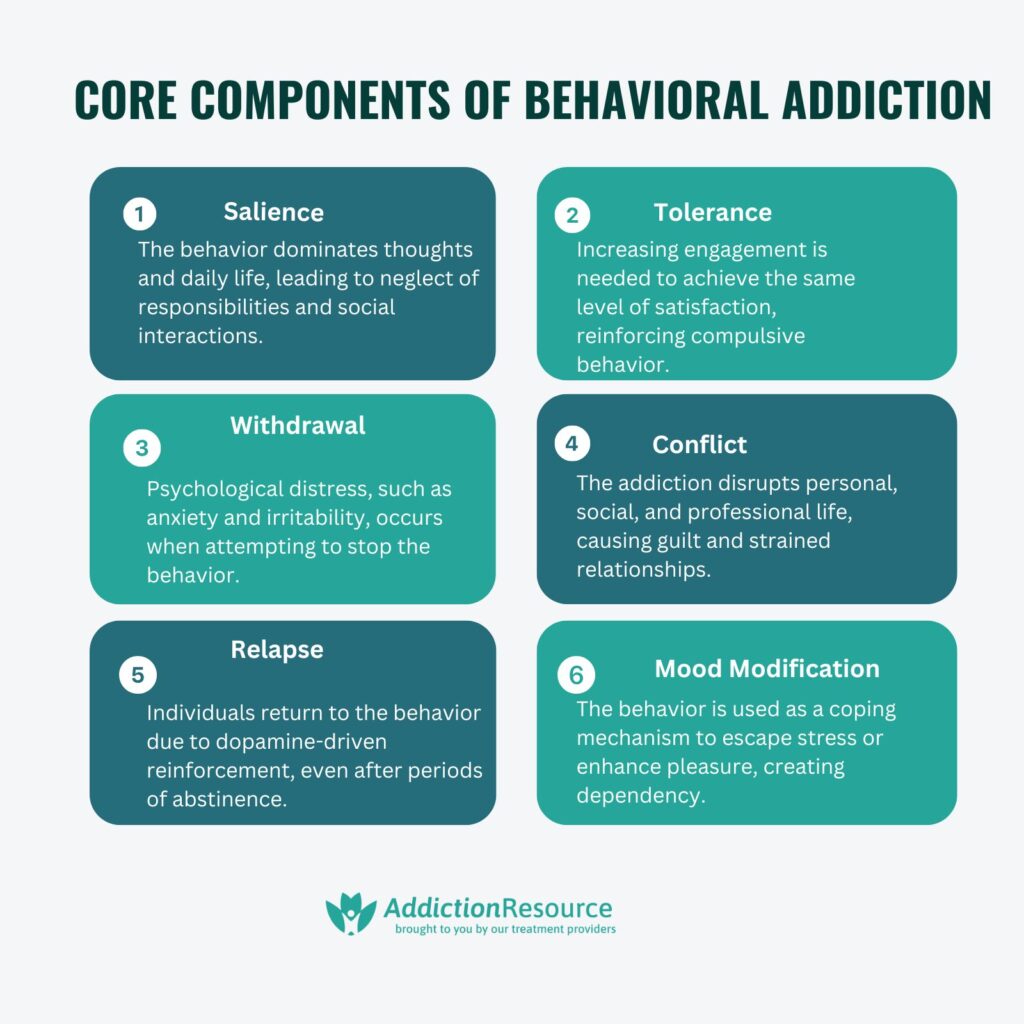
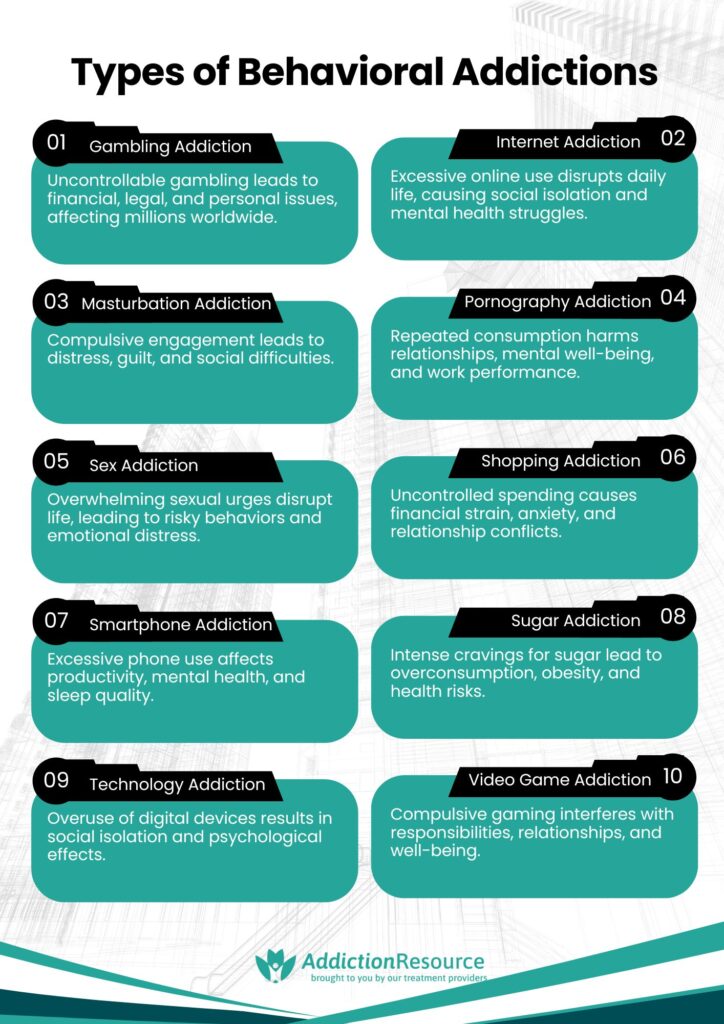
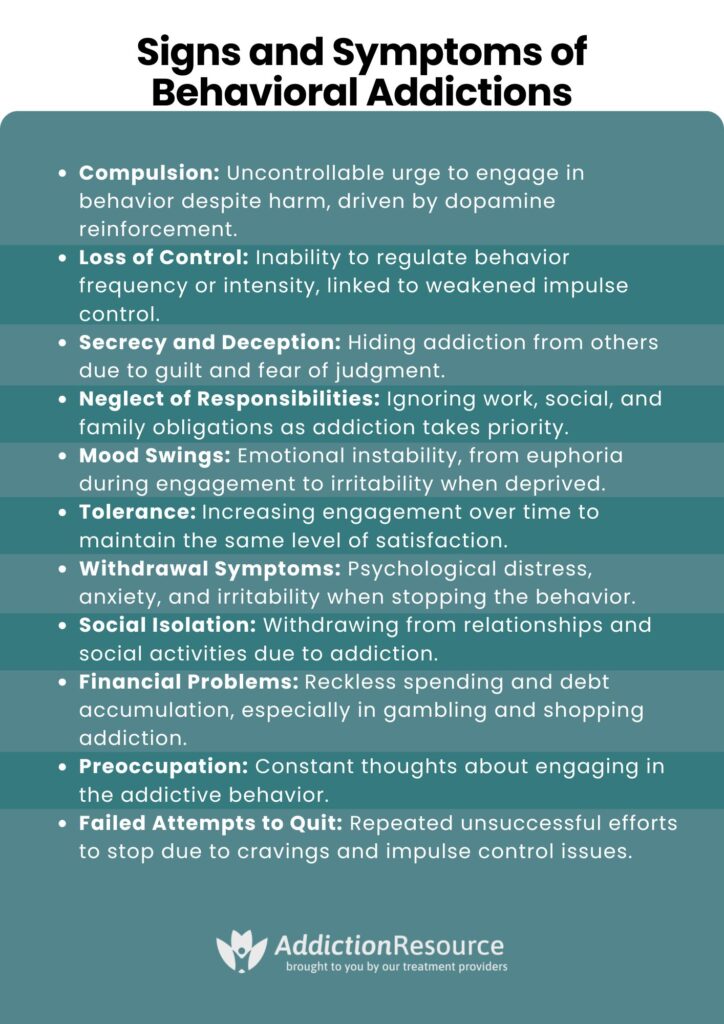

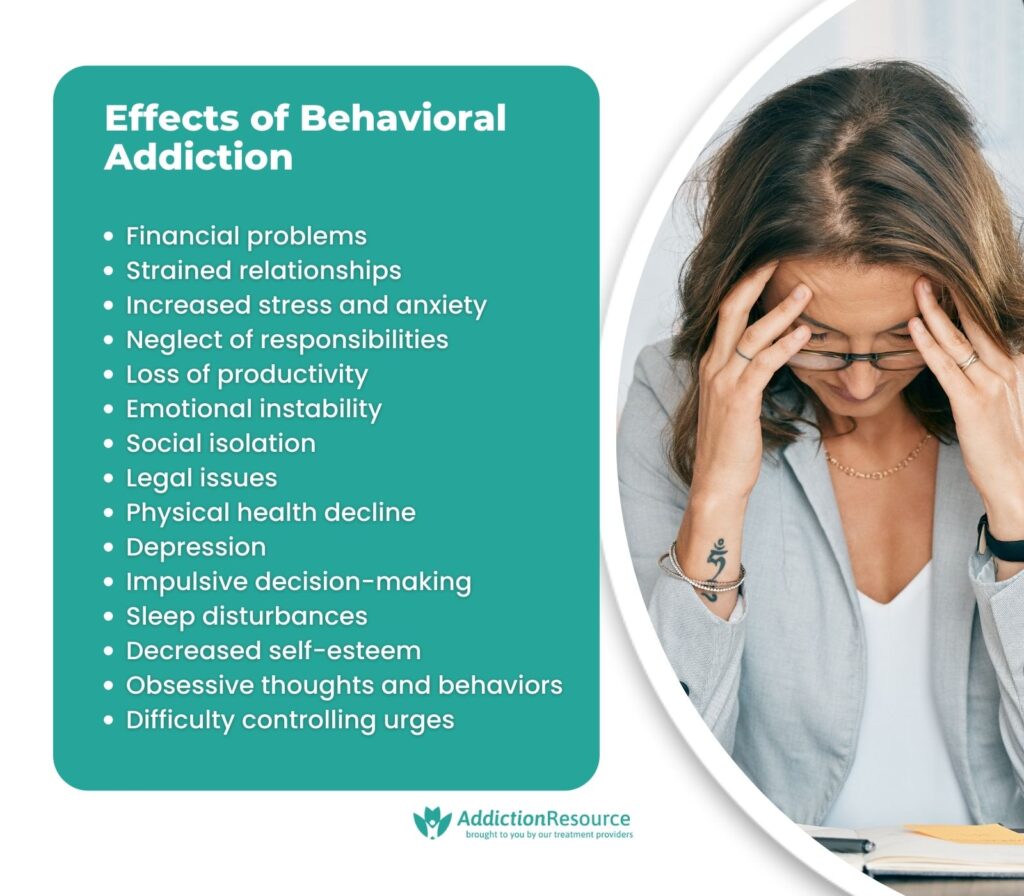
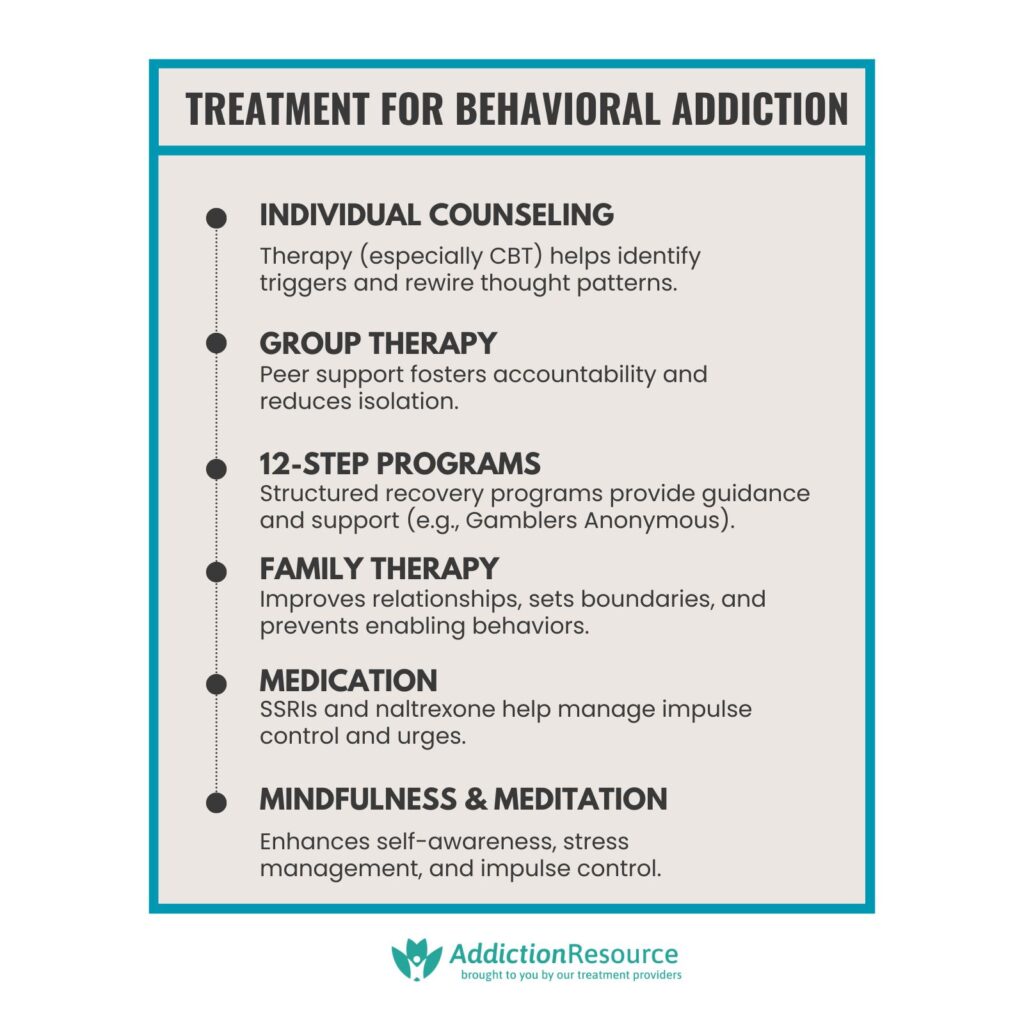

 FindTreatment.gov
FindTreatment.gov